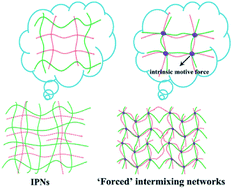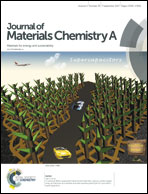Epoxy/polysiloxane intimate intermixing networks driven by intrinsic motive force to achieve ultralow-temperature damping properties†
Abstract
The preparation of highly incompatible interpenetrating polymer network systems with a high extent of phase mixing has been a challenging task because the thermodynamics of phase separation are so powerful. Here, we propose a facial strategy to design a ‘forced’ intermixing epoxy/polysiloxane network by utilizing a novel epoxy/polysiloxane monomer (SH-EP) in a one-pot synthesis. The relationship between the structure and properties is systematically investigated using FTIR spectrometry, rheology, SEM, and DMA. Impressively, the epoxy and polysiloxane networks can be driven to closely interpenetrate by their intrinsic motive force derived from the ‘forced’ sites in SH-EP, which in turn, may easily give rise to a bicontinuous morphology. In addition, the gelation time is systematically controlled by varying the polysiloxane content and pre-curing temperature. By tuning the gelation time, the extent of phase mixing and the degree of phase separation can be further regulated. The result is striking: for the first time, these highly incompatible epoxy/polysiloxane intermixing networks exhibit ultralow-temperature damping properties (tan δ > 0.3) over a very broad temperature range of 217 °C (from −114 °C to 103 °C). This finding may revolutionise the frontiers of materials knowledge.



 Please wait while we load your content...
Please wait while we load your content...